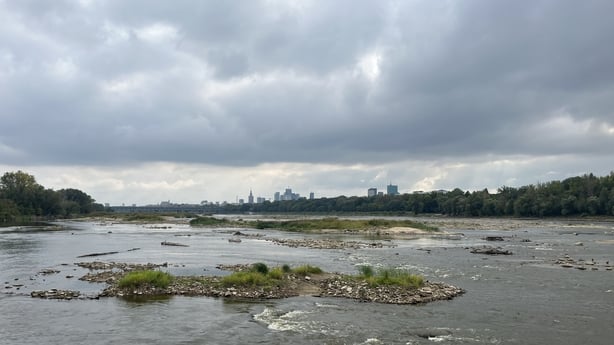Walking along the banks of the Vistula river in Warsaw this week, one thing was striking: the shallow water level.
Sand banks had been exposed in places and little islands of stones, normally hidden far below the water level, had emerged for seagulls to use as landing ports.
Tourist boats were tied up and Varsovians snapped pictures on their phones to capture the historic, if not sad, view of the great river.
The Vistula is Poland's longest river and the ninth longest in Europe.
It flows north through Poland, beginning in the south of the country, moving through Kraków, then Warsaw and on towards Gdańsk before flowing into the Baltic Sea.
For the past week, the river has been in a state of hydrological drought.
Its low level is most acute around Warsaw and the central Mazovia region where the riverbed is in its most natural state.
On Wednesday, a monitoring station in the capital, run by the Polish meteorological institute (IMGW), measured a depth of only 20 centimetres.
Normally, at this time of year, the same stretch of the river averages a depth of between 1.5 and 2 metres.
"We can say with confidence that this is the effect of climate change," Grzegorz Walijewski, spokesperson for the Polish meteorological institute (IMGW), told RTÉ News.
Mr Walijewski, who is a hydrologist, said: "We have more and more days without precipitation, and when it does occur, it is in a very highly concentrated form", meaning, it pours.
He also said that some fish have problems to function properly in the Vistula's current low levels because "there is not enough oxygen". Other experts say that fish can easily seek out deeper tributaries when the water level of a main river becomes too low.
Wednesday’s record low level beat a previous record from the summer of 2015. That year, the depleted river revealed statues and other treasures from the seventeenth century, believed to have been stolen by an invading Swedish army during a period that Polish historians aptly call 'the deluge’.

However, the Vistula is not the only Polish river that is suffering from drought this September.
From the Polish meteorological institute’s (IMGW) 600 stations that automatically measure water levels throughout Poland, more than a third are dealing with drought conditions.
The same institute’s data show that just over 70% of Poland’s rivers and waterways currently have low levels of water.
It has been a very hot summer in Poland and in neighbouring countries, with temperatures often reaching 30 degrees Celsius, and sometimes higher, since June. Rainfall has also been rare.
Drought warnings for some Polish rivers were issued as early as the beginning of May this year.
While summers have heated up in the region, Polish winters have become more mild during the past decade, resulting in reduced amounts of melting snow flowing into rivers.
Poland’s average temperature increased by just over 2°C during the past 70 years according to data from the Paris-based International Energy Agency (IEA), matching a trend recorded across much of the globe.
However, in the past two decades, IEA data show that the country's average temperature increase - 0.05°C per year - has surpassed the global average of 0.03°C per year.
"The high temperature causes high evaporation and even if some rains or storms appear, the water disappears. It is not stored in the ground as it used to be," Piotr Panek, a Polish environmental biologist, told RTÉ News.
"When the ground is desiccated, it forms some kind of crust and the rainwater does not soak into the ground," said Mr Panek, chief specialist at the Polish government's Chief Inspectorate of Environmental Protection.
Droughts in Poland, he said, were less predictable than in recent decades and last longer.
"It isn't normal when something that used to be an extreme event becomes a usual, everyday event. Now some events that were extreme 25 years ago, became a typical situation and this is worrying".
After such a warm summer, torrential rainfall and severe flooding is forecast for south-western Poland, the Czech Republic, Slovakia, Austria and eastern Germany over the weekend.
Major flood-protection measures are being put in place by emergency services in the five countries.
But experts say it could take a week or slightly longer before the Vistula returns to its average levels.






